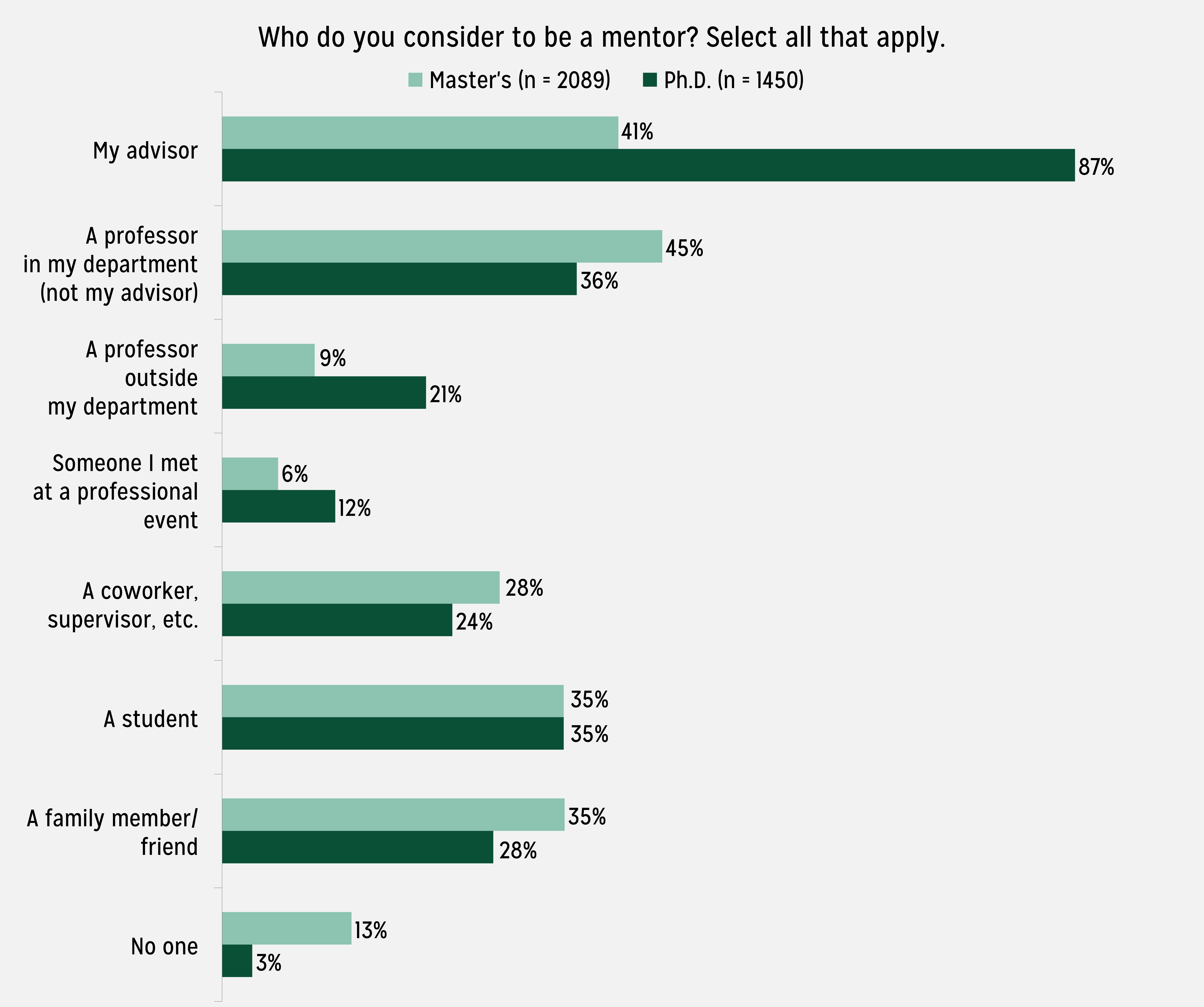Master’s and Ph.D. Students in Computing Have Different Sources of Mentorship
 Master’s and Ph.D. students reported the individuals they consider to be their mentors in CERP’s 2016 Data Buddies survey. While most Ph.D. students (87%) reported their advisor was among their mentors, only 41% of Master’s students did so. More Master’s students compared to Ph.D. students reported having a coworker/supervisor and/or a family member/friend as one of their mentors. Most significantly, 13% of Master’s students reported not having a mentor at all compared to 3% of Ph.D. students. Given the importance of mentorship for selecting a career path and excelling in it [1, 2], it is important to understand the types of mentorship computing graduate students receive.
Master’s and Ph.D. students reported the individuals they consider to be their mentors in CERP’s 2016 Data Buddies survey. While most Ph.D. students (87%) reported their advisor was among their mentors, only 41% of Master’s students did so. More Master’s students compared to Ph.D. students reported having a coworker/supervisor and/or a family member/friend as one of their mentors. Most significantly, 13% of Master’s students reported not having a mentor at all compared to 3% of Ph.D. students. Given the importance of mentorship for selecting a career path and excelling in it [1, 2], it is important to understand the types of mentorship computing graduate students receive.
Notes:
The survey question used for this analysis was as follows: A mentor is someone with whom you have an ongoing relationship, and who provides you advice and assistance in advancing in your career. Among the people below, who do you consider to be a mentor? Please select all that apply. The choices were: My advisor; A professor within my department (not my advisor); A professor outside of my department; A student (e.g., graduate student, Teaching Assistant, peer); Someone I met at a conference or mentoring program sponsored (or other professional activity); A family member/partner, friend, pastor, or someone else with whom I have a personal relationship; A coworker, supervisor, or someone else with whom I have a professional relationship; Someone else; No one. The “someone else” option was excluded from analysis because less than 2% of the respondents selected this option. A total of 3,851 students (2,303 Master’s and 1,548 Ph.D.) responded to the survey. Eight percent of all respondents (n = 312; n = 214 Master’s and n = 98 Ph.D.) did not provide a response to the mentor question. Chi-squared tests were run to test whether Master’s and Ph.D. students selected each option at different rates. Master’s and Ph.D. students’ rate of mentorship is statistically significant (p < .05) across all categories, with the exception of having “a student” as a mentor.
References:
- Francine D. Blau, Janet M. Currie, Rachel T. A. Croson, and Donna K. Ginther. (2010). Can Mentoring Help Female Assistant Professors? Interim Results from a Randomized Trial. American Economic Review, 100(2), 348–52.
- Roberta Ambrosino. (2009). Mentors as Fellow Travelers. Adult Learning, 20(1), 31–34.
 This analysis is brought to you by the CRA’s Center for Evaluating the Research Pipeline (CERP). CERP provides social science research and comparative evaluation for the computing community. To subscribe to the CERP newsletter, click here.
This analysis is brought to you by the CRA’s Center for Evaluating the Research Pipeline (CERP). CERP provides social science research and comparative evaluation for the computing community. To subscribe to the CERP newsletter, click here.
This material is based upon work supported by the National Science Foundation under Grant Number (CNS-1246649; and/ or DUE-1431112). Any opinions, findings, and conclusions or recommendations expressed in this material are those of the author(s) and do not necessarily reflect the views of the National Science Foundation.








